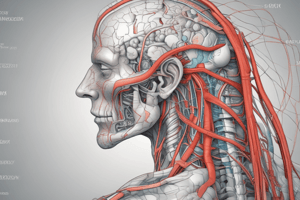Podcast
Questions and Answers
What type of muscle action occurs when a muscle shortens during contraction?
What type of muscle action occurs when a muscle shortens during contraction?
- Concentric (correct)
- Isometric
- Antagonistic
- Eccentric
Which muscle action allows a muscle to lengthen while still under tension?
Which muscle action allows a muscle to lengthen while still under tension?
- Agonistic
- Eccentric (correct)
- Concentric
- Isometric
In the context of muscle actions, what is the role of a synergist?
In the context of muscle actions, what is the role of a synergist?
- To assist the agonist (correct)
- To oppose the agonist
- To primary drive the movement
- To stabilize the joint
What is the primary role of the stabilizer muscles during movement?
What is the primary role of the stabilizer muscles during movement?
How does muscle fiber composition influence muscle actions?
How does muscle fiber composition influence muscle actions?
Which factor primarily determines the range and type of motion in muscle actions?
Which factor primarily determines the range and type of motion in muscle actions?
Flashcards
Concentric Muscle Action
Concentric Muscle Action
Muscle shortens during contraction, such as lifting a weight.
Eccentric Muscle Action
Eccentric Muscle Action
Muscle lengthens under tension, like lowering a weight.
Isometric Muscle Action
Isometric Muscle Action
Muscle generates force without changing length, like holding a plank.
Agonist Muscle
Agonist Muscle
Signup and view all the flashcards
Antagonist Muscle
Antagonist Muscle
Signup and view all the flashcards
Synergist Muscle
Synergist Muscle
Signup and view all the flashcards
Study Notes
Muscle Actions
-
Types of Muscle Actions:
-
Concentric:
- Muscle shortens during contraction.
- Example: Bicep curl (lifting the weight).
-
Eccentric:
- Muscle lengthens under tension.
- Example: Lowering the weight in a bicep curl.
-
Isometric:
- Muscle length remains unchanged while generating force.
- Example: Holding a plank position.
-
-
Muscle Action Classification:
-
Agonist:
- Primary muscle responsible for the movement.
- Example: Biceps during elbow flexion.
-
Antagonist:
- Muscle that opposes the action of the agonist.
- Example: Triceps during elbow flexion.
-
Synergist:
- Assists the agonist in performing its action.
- Example: Brachialis assisting biceps in elbow flexion.
-
Stabilizer:
- Muscle that supports a body part and maintains posture during movement.
- Example: Core muscles during a squat.
-
-
Factors Influencing Muscle Actions:
- Joint type: Determines range and type of motion (e.g., hinge, ball-and-socket).
- Muscle fiber composition: Fast-twitch vs. slow-twitch fibers affect endurance and strength.
- Neuromuscular control: Coordination between nervous system and muscle actions.
-
Functional Importance:
- Muscle actions are involved in all physical activities, from daily tasks to athletic performance.
- Understanding muscle actions aids in rehabilitation, athletic training, and improving overall fitness.
Types of Muscle Actions
- Concentric: Muscle contracts and shortens, such as during a bicep curl when lifting a weight.
- Eccentric: Muscle generates tension while lengthening, exemplified by lowering a weight in a bicep curl.
- Isometric: Muscle tension occurs without changing length; for instance, maintaining a plank position.
Muscle Action Classification
- Agonist: The primary muscle responsible for initiating a movement, like the biceps in elbow flexion.
- Antagonist: The opposing muscle that counteracts the agonist's action, such as triceps during elbow flexion.
- Synergist: Assists the agonist in movement execution; for example, the brachialis helps the biceps in elbow flexion.
- Stabilizer: Supports body parts and maintains posture during dynamic actions, like core muscles engaged during a squat.
Factors Influencing Muscle Actions
- Joint Type: Affects the range and form of motion depending on the joint classification (e.g., hinge or ball-and-socket).
- Muscle Fiber Composition: Variations in fast-twitch versus slow-twitch fibers impact muscle strength and endurance capacities.
- Neuromuscular Control: The interplay between the nervous system and muscle actions is crucial for coordination and efficient movement.
Functional Importance
- Muscle actions are integral to all physical activities, impacting everything from routine daily tasks to high-performance sports.
- Knowledge of muscle actions enhances rehabilitation practices, athletic training effectiveness, and overall fitness improvement.
Studying That Suits You
Use AI to generate personalized quizzes and flashcards to suit your learning preferences.




